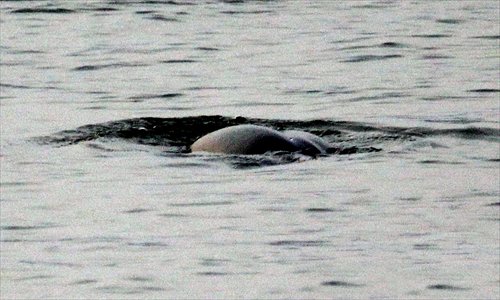Porpoise population plummets


Experts have estimated that the population of Yangtze finless porpoises in the Yangtze River between Shanghai and Wuhan, Hubei Province, has fallen by about one-third over the last six years, local media reported.
A team of researchers sponsored by the World Wildlife Fund (WWF) and the Institute of Hydrobiology, Chinese Academy of Sciences (CAS) departed from Wuhan by boat in early November to study the endangered species, according to a news report Wednesday on the television station Dragon TV.
The team did not observe any porpoises after passing through Jiangyin, Jiangsu Province, on their way down the river, said Zhang Xinqiao, an officer from the WWF's China branch. "But I myself saw two porpoises along the Yangtze River in Shanghai while we were doing similar research in 2006," Zhang told the Global Times.
The research group inferred from their observations in 2006 that an estimated 1,800 porpoises had been living in the area, according to the Oriental Morning Post. They projected that the porpoise population could fall below 1,400 this year.
Wang Ding, a researcher with the Institute of Hydrobiology, said there might be a sharp decrease in the number of porpoises in the river near Shanghai due to the heavy shipping industry, Dragon TV reported.
"There are too many cargo ships running in the river's lower reaches, and it is becoming more dangerous for porpoises to reside in this area," Zhang told the Global Times.
Zhang said he often receives reports about porpoises getting cut by ship propellers.
Tang Wenqiao, an expert from Shanghai Ocean University, agreed that there has been a sharp decline in the number of porpoises in Shanghai.
"When I started paying attention to this now endangered species in 2003, it was easy to observe porpoises swimming in groups of more than 100," Tang told the Global Times.
However, Tang's research team only managed to observe eight porpoises in Shanghai during a three-week research project in May, he said.
The number of porpoises is far less than the number found in the upper reaches, where there are fewer ships.
The WWF and CAS team found 45 porpoises in the river between Hukou, Jiangxi Province, and Anqing, Anhui Province, according to the Oriental Morning Post.
There are usually fewer porpoises in Shanghai in the winter because of the lower water level, Tang said.
If the situation doesn't change, Zhang said the Yangtze finless porpoise could end up like the White-flag dolphin, an aquatic mammal species that used to live in the Yangtze River, and die out in 15 years.